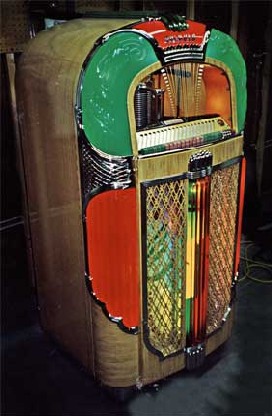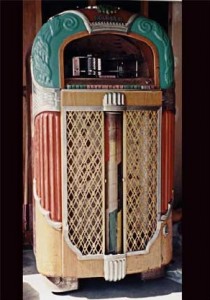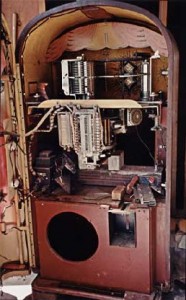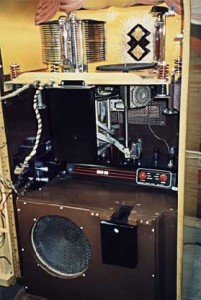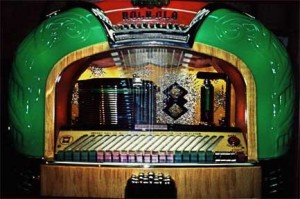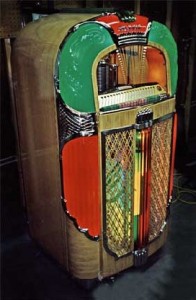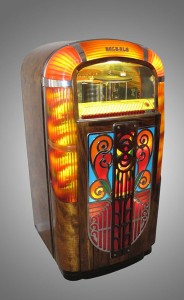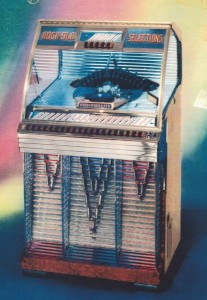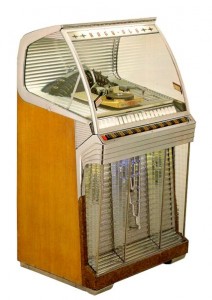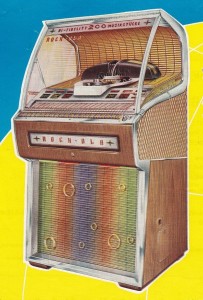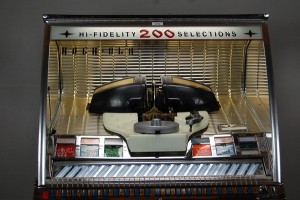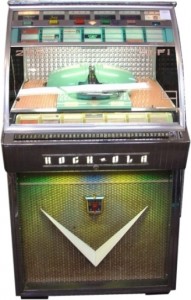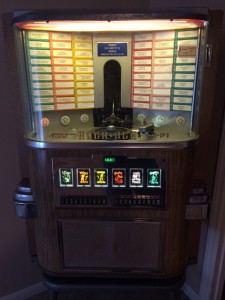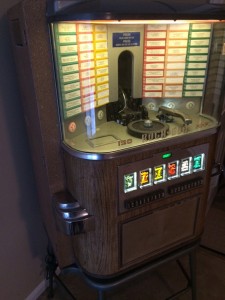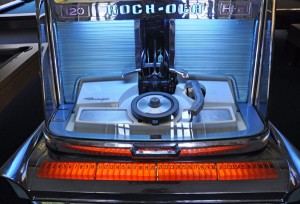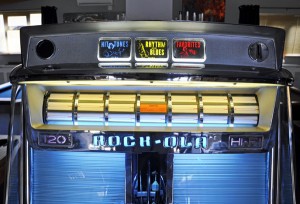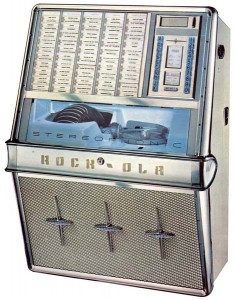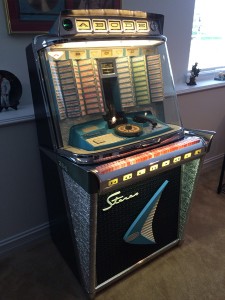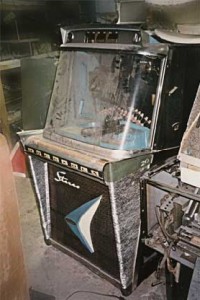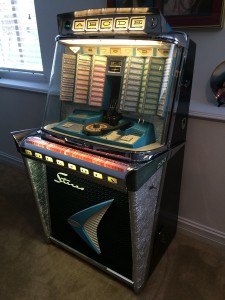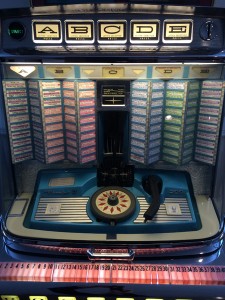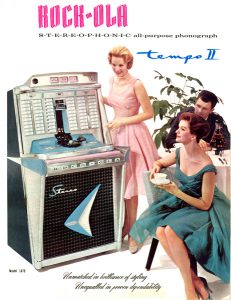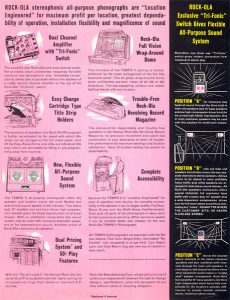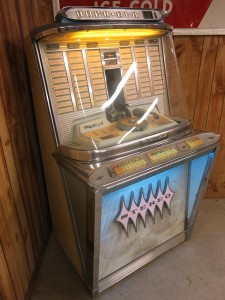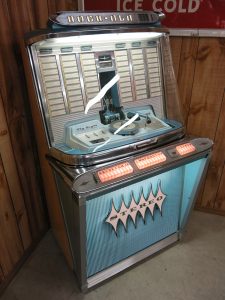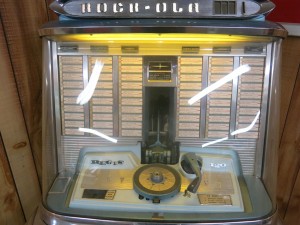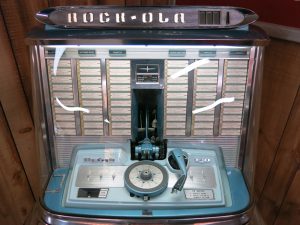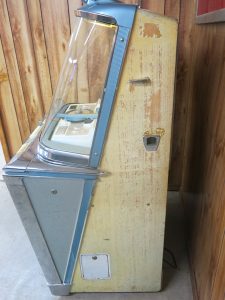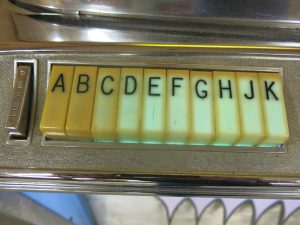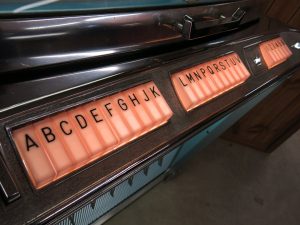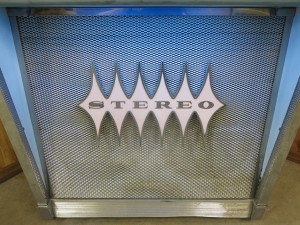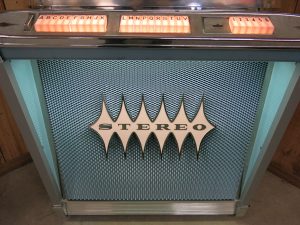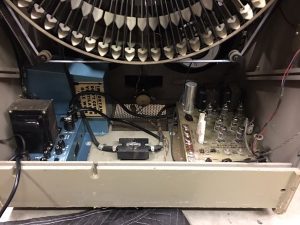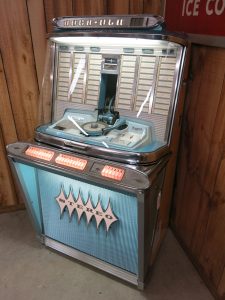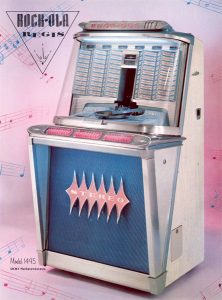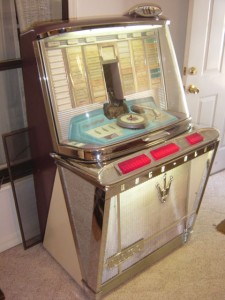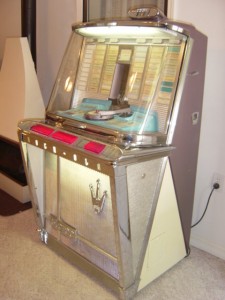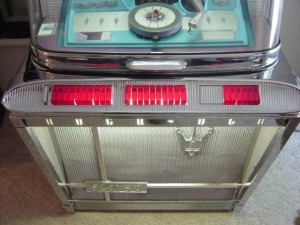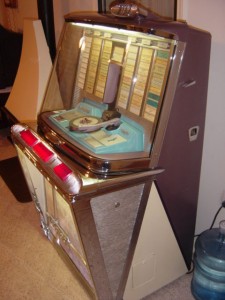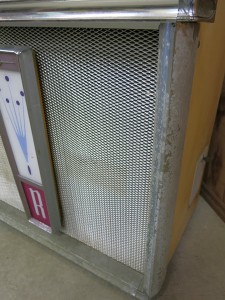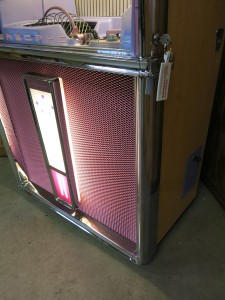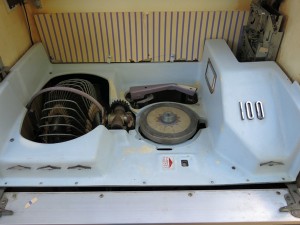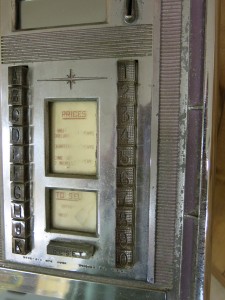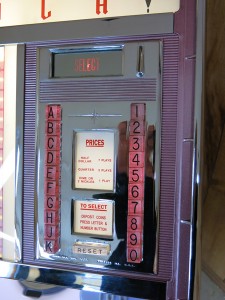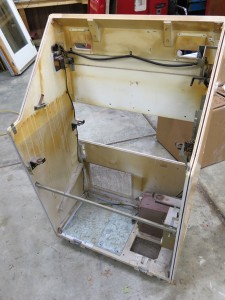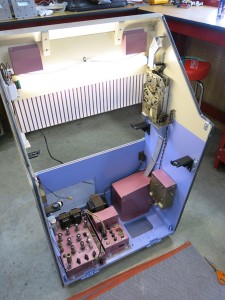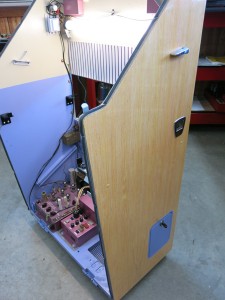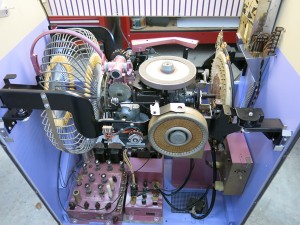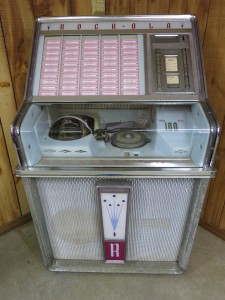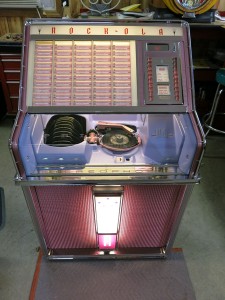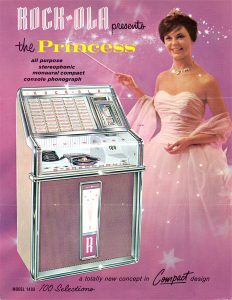For over 30 years, Grand America Jukebox has performed Rockola Jukebox Restoration and Repair on Vintage Rock-ola Jukeboxes for clients all over the world
Let Grand America Jukebox restore or repair your classic Rock-ola Jukebox
Touch Here For A Brief history of Rock-ola Jukebox 1935: Rock-ola enters the Jukebox market following the repeal of Prohibition. It manufactures Jukeboxes and many other items, at its Chicago, IL plant (until 1992). Prior to entering the Jukebox market, Rock-ola was very successful in manufacturing coin operated scales, penny arcade and gambling machines 1985: Antique Apparatus Company (in Torrance, CA) enters the Jukebox market. AA manufactures high end reproductions of 1940’s Wurlitzer Jukebox cabinets equipped with Rowe/AMI Jukebox mechanisms. In September 1992, Antique Apparatus purchases the Rock-ola Jukebox company. Rock-ola then becomes “Antique Apparatus / Rock-ola Manufacturing” and moves all operations to Torrance, CA, where it manufactures NEW Rock-ola Jukeboxes today 1993: Rock-ola CD mechanisms replace Rowe/AMI mechanisms in all AA brand Jukeboxes (this is the Black Rock-ola S-5A computer systems) 1995: Rock-ola updates their computer to the Black S-6-1 system in hopes of making it more reliable and giving more options (This is the last Rock-ola system to offer knobs for Bass and Treble settings) 1996: Rock-ola introduces its new Red “SyberSonic” Computer and Amplifier system (replacing the Black Rock-ola S-5A and S-6-1 systems). This Red SyberSonic system becomes their first truly reliable system for Rock-ola. The Red SyberSonic system features buttons to adjust Bass and Treble on the amplifier 1997: Rock-ola introduces the new Orange “Advanced SyberSonic” Computer and Amplifier system, replacing the Red SyberSonic system. Bass and Treble settings are now set through the front selector keypad buttons. No buttons or knobs on the amplifier Sept, 2003: Rock-ola introduces its new Yellow “SyberSonic” Computer and Amplifier system, with even more options. This computer system is still used today 2007: iPod docking option is offered May, 2010: Rock-ola Jukeboxes now come with “Peavey” 1600 watt amplifiers (these are the Silver Peavey amplifiers replacing the previous Yellow Rock-ola amplifiers. However, still using the Yellow “SyberSonic” computers) May, 2014: “Peavey” amplifiers are now upgraded to a new Black 2000 watt amplifier in all Rock-ola Jukeboxes 2015: Apple introduces a new “Lighting” plug connector for its iPod’s and iPhones, which no longer work with the 30 pin iPod docking stations. This forces Rock-ola to drop the iPod docking option 2017: Rock-ola introduces LED lighting and Bluetooth in all Jukebox models June 2019: The Games Room Company (from England) purchases Rock-ola Jukebox Manufacturing, and announces they will build a new 45 rpm Vinyl Bubbler. The new 45 rpm Bubbler was introduced in March of 2020 Dec 2023: Rock-ola Jukebox Manufacturing announces the re-introduction of a new 3200 Bubbler speaker in a limited run of only 100 units. Though production does not begin until Dec of 2025 due to parts supply issues Grand America Jukebox in St Louis, MO Performs 1940’s Rock-ola Jukebox Restoration on models 1422 – 1428 1950’s & 60’s Rock-ola Jukebox Restoration on models 1448 – 1497 1993 – Present, Antique Apparatus Rock-ola Jukebox Repair To find out what model Rock-ola Jukebox you have, locate the metal ID tag fastened to the cabinet. You will need the Model number from that Metal ID tag, to choose a selection below Where is the Metal ID tag located? The Metal ID tag is mounted outside the cabinet, on the back of the Jukebox Select a Rock-ola Jukebox model below for more information and photos Late 1940’s Rock-ola Jukeboxes Early 1950’s Rock-ola Jukeboxes Mid – Late 1950’s Rock-ola Jukeboxes 1455 Wall Phonograph 1464 Tempo I 1468/1475 Early 1960’s Rock-ola Jukeboxes Wall Phonograph 1484 1985 to Present AA/Rock-ola JukeboxesContact us
636-928-1010
doc2stat@yahoo.com
Cell 314-413-0513
Rock-ola 1422, 1426, & 1428 Jukebox Restoration and Repair
1428 Rock-ola Jukebox Restoration and Repair. Grand America Jukebox Fully Restored this 1948 Rock-ola 1428 Jukebox. This Rock-ola Jukebox Restoration arrived in pretty solid shape but, missing the front animation plastic and mechanism glass. Our Rockola Jukebox Restoration consisted of re-chroming all castings, replaced the grill cloth with the original pattern, replaced the top green plastics, center animation plastic and we were able to restore many of the other original, light up plastics
Inside the Rock-ola 1428 Jukebox Restoration before, shows pretty solid, missing only some metal dust covers. For our Full Rockola Jukebox Restoration, we dis-assembled the cabinet, stripped the finish then applied a faux wood finish, like the factory. We repainted the inside cabinet, rebuilt the amplifier (new capacitors, tubes, painted and decaled), re-coned the original speaker, went through the mechanism completely, installed a new power cord and new casters
After
We replaced the Rock-ola 1428 Jukebox mechanism glass with the correct, original frosted pattern, we rebuilt the selector buttons and replaced all light bulbs
After
We refinished the Rockola Jukebox cabinet in a factory looking, Faux wood grain finish
Rock-ola 1428 Jukebox Restoration. Fully Restored and ready for years of new use
Touch Here For Rock-ola 1422, 1426, & 1428 Jukebox History 1946: Following WWII, Rock-ola introduced a new series of Jukeboxes featuring a new cabinet design, internal features, and re-introduced, a viewable record playing mechanism. First introduced was the Rock-ola 1422 for 1946, the Rock-ola 1426 came the following year (1947). And finally, the Rock-ola 1428 Jukebox for 1948 (which continued production through 1949) All three Rock-ola Jukebox models feature Rock-ola 1422 Jukebox 1946: Rock-ola introduces the Rock-ola 1422 featuring a dark wood cabinet, decretive wood grill with rainbow animation on the outside pilaster plastics and florescent lighting Rock-ola 1426 Jukebox 1947: Rock-ola introduces the Rock-ola 1426 offered the same features as the 1422, but with a decretive chrome grill. Also added to the Rock-ola 1426, were florescent light starters which allowed for automatic lighting when you flipped on the power switch (you no longer had to hold the start switch on the back of the jukebox to light the florescent lights) Rock-ola 1428 Jukebox Touch Here For Rock-ola 1428 Jukebox History Following WWII, Rock-ola was really competing with Wurlitzer’s round top Jukeboxes. Wurlitzer had great success in 1946-1947 with its model 1015 bubbler Jukebox (of which it sold around 60,000) and Rock-ola certainly took notice 1948: Rock-ola introduces the model 1428 Jukebox which offered many new features over the previous 1422 & 1426. The whole front door was made of steel (to reduce sagging and warping) and was covered in a faux wood decal. The finish was in a Bleached Mahogany, (much lighter than the two previous models). The base of the Jukebox was redesigned to be more like a “skid”, separated into two parts which add strength and stability. The coin mechanism was moved from under the mechanism to inside the front door (this allowed quicker access for repairs). Other new features included a new light weight, plastic tone arm and new trip switch, (it was advertised that records will now cancel on just 1/2 oz pick up arm pressure). A new improved amplifier. And the most noticeable change was the new, large “Magic-Glo” rotating color cylinder located in the center of the speaker grill. These features make the Rock-ola 1428 Jukebox very collectible today Also in 1948: Seeburg Jukebox (a competitor) introduces a new Jukebox mechanism that would prove tough for Rock-ola. The Seeburg A Jukebox with its new Select-o-matic mechanism, offering “100” selections 1949: Having just spent quite a lot of money designing and manufacturing the Rock-ola 1448 Jukebox, and needing time to react to the new Seeburg A Select-o-matic mechanism, Rock-ola continued to manufacture the Rock-ola 1448 Jukebox through 1949 The Rock-ola 1422, 1426 and 1428 Jukeboxes feature a 20 play, 78rpm record mechanism that holds 20 records horizontally (like a stack of pancakes). The Rock-ola 20 play record mechanism will play the top side of the record only. Each record is placed on a felt covered tray that is then placed into a numbered record ring on the mechanism stack. Grand America Jukebox offers three options for your Rock-ola Jukebox View our main Jukeboxes page to see everything included in both Full and Partial Restorations Email photos of your Rockola Jukebox to get a quote
A new light weight tone arm
A 20 selection, 78 rpm mechanism with all 20 selector buttons lined up (keyboard style), and title strips listed right above each button (this was different from previous years)
A newly designed Electrical Junction Box
Screw down mechanism chassis anchors (for quickly securing the whole mechanism during transport)
Quick record tray release (to change records)
A completely viewable mechanism, visible through an etched glass window (the Rock-ola Jukebox mechanism had been hidden from view since 1939)
And a complete, light up front door assembly that offers full accessibility to all lights and colored animation (in previous years, Rock-ola Jukeboxes were simply harder to service)
The differences between these three Rockola Jukebox models being, cosmetics and some internal features
All three models are reliable and very sought after Jukeboxes. The Rock-ola 1428 Jukebox (being the most popular of these three models), offers more reproductions parts available today
Contact us
636-928-1010
doc2stat@yahoo.com
Cell 314-413-0513
Rock-ola Jukebox Early 1950’s Transition History
Touch Here For Early 50's Jukebox History 1946: Rock-ola’s early 1950’s Jukebox History actually begins in 1946, after WWII. Jukebox production returned, customers were once again spending money and the competition to get those customers was on. For the Jukebox market, big changes were made in the way of exterior cosmetics, sound quality and the amount of selections. Each Jukebox manufacture competing for more customer sales and trying to out do each other in the process. For 1946, Rock-ola and Seeburg each featured 20 selection Jukeboxes, while Wurlitzer had been leading customer sales featuring a 24 play mechanism and beautiful designed Jukebox cabinets. Rock-ola quickly began copying Wurlitzer cabinet designs with the Rock-ola 1422, 1426 and 1428 Jukeboxes (which sold for less cost than the Wurlitzer models, putting Rock-ola in second place for over all sales) 1949: With Seeburg’s increased sales, Wurlitzer and Rock-ola began to struggle, in all aspects. Rock-ola had just introduced the model 1428 Jukebox (in 1948). Sales were pretty good but, Rock-ola needed to make big changes if they wanted to stay competitive. They continued production of the model 1428 Jukebox into 1949, giving them time to work on new ideas Touch Here For Rock-ola 1432/1434 Jukebox History Late 1950: Rock-ola introduces the Rock-ola 1432 Jukebox for the 1951 model year. That same year, the new 45 rpm record and 33-1/3 rpm LP record designs had just been introduced by the major record companies. However, not many customers had the new 45’s. The Rock-ola 1432 was introduced as a 78 rpm Jukebox, available converted to the new 45 record and the new 33-1/3 LP. With that problem solved, the next problem was the amount of selections. Rock-ola had been using its 20 play “Pancake Stack” style mechanism for a decade, and needed to push the design for more selections. They added 5 more record selections and re-designed the mechanism to play both sides of each record by using a twin-head tone arm. One to play the top of the record, and one to play the bottom. This required a special turn table motor that could turn in two directions. But, would now allowed for 50 selections total (still half of what Seeburg was selling). Though Rock-ola was re-using many of its 1940’s mechanics and electronics, Rock-ola did try hard to change their cabinet design toward the “Console” look (that Seeburg was using successfully). Using many clear plastics, the Rock-ola 1432 Jukebox had a much more viewable mechanism and rounded front to back look 1952: Rock-ola introduces a new 120 selection mechanism exclusively for the 45 rpm record (a year after Seeburg). For 1952, the Rock-ola 1432 Jukebox was available with the 50 selection, 78 rpm mechanism (for smaller locations and less cost) or, the more expensive 120 selection, 45 rpm mechanism for larger locations Touch Here For Rock-ola 1436 Jukebox History 1952: Rock-ola introduces a new 120 play mechanism (called the “Fireball 120”) made exclusively for the 45 rpm record. This mechanism was offered in the Rock-ola 1432 and 1434 Jukeboxes as an option. But, was featured exclusively in the NEW Rock-ola 1436 Jukebox of 1952 and 1953. Having 120 selections required a re-design of the title strip and selection area. For this, Rock-ola chose an idea Wurlitzer had used in the 1948 Wurlitzer 1100 Jukebox, “Rotating title strips”. Rock-ola used a three sided drum, each side of the drum holding 20 title strips. Only one side of the drum was viewable at a time, and would correspond to a row of 20 selection buttons. You simply pushed the selection button under the current title strip to make that selection. If you did not prefer any of the 20 selections visible at that time, pushing the “Program” button would rotate the drum to display another 20 selections, and so on. These were very innovative idea that began to get Rock-ola Jukebox back on top Touch Here For Rock-ola 1438/1446 Jukebox History December, 1953: Rock-ola introduces the model 1438 “Comet-Fireball” Jukebox. A new cabinet design that was a major leap for Rock-ola (But to the public, appeared very similar to the 1952 Seeburg C Jukebox). The Rock-ola 1438 Jukebox had very similar mechanism dome glass and plastic grill pilasters with color changing lights as the Seeburg C. Even having a similar speaker grill design Also in 1953: Seeburg Jukebox had begun using a new feature, “High-Fidelity” audio sound. Rock-ola quickly designed a new amplifier that could produce “Hi-Fi” sound, and introduces it in June of 1954, as the Rock-ola 1446 Jukebox (which featured the same cabinet and mechanism as the Rockola 1438) Touch Here For Rock-ola 1442 Jukebox History 1954: Rock-ola introduces the economy model 1442 Jukebox for smaller locations. A 50 play, 45 rpm Jukebox at less cost than the 1438/1446 Jukeboxes. The Rock-ola 1442 Jukebox featured its own cabinet design. Similar in looks to Seeburg’s Jukeboxes, but with a completely different grill, using many vertical bars and a single light up center plastic. The Rock-ola 1442 Jukebox replaced the 1432 and 1434 models Reliability, cabinet designs and sales on all early 50’s Rock-ola Jukeboxes were not great. This is why today, these early 50’s Rock-ola Jukeboxes do not have a large demand, few reproduction parts exist, and Jukebox values are minimal This all began to change for Rock-ola Jukebox in 1955 with a new cabinet design
1948: Seeburg (a competitor) was lagging in Jukebox sales from its model 146, 147, and 148 models (today known as the “Trash can” models) and chose to re-design its mechanism, and cabinet design from the ground up. This lead to the introduction of the 1948 Seeburg “A” Jukebox with its “Select-O-Matic” mechanism. This new Seeburg Jukebox mechanism held 50 records and could play both sides offering 100 selections of 78 rpm records. The Select-o-matic mechanism was small and proved to be very reliable. Seeburg introduced this mechanism in a new cabinet design as well. The Seeburg “A” Jukebox was more of a “Console” type, showing wider than tall. A very modern look for the time. Both changes were very different and customers began to buy
Also in 1952: Rock-ola introduces the Rock-ola 1434 Jukebox (which they simply tried to enhance the cosmetics more). The Rock-ola 1434 Jukebox featured a full view clear plastic mechanism dome and huge light up plastic pilasters on the outside of the grill area which did help to increase sales some. The Rock-ola 1434 Jukebox was available with the same mechanism options as the model 1432, the 50 selection 78 rpm mechanism or the upgraded 120 selection, 45 rpm mechanismContact us
636-928-1010
doc2stat@yahoo.com
Rock-ola 1448, 1452, & 1454 Jukebox Restoration and Repair
1452 Rock-ola Jukebox
Rock-ola 1448, 1452, & 1454 Jukebox Restoration and Repair. Probably the most common Rock-ola Jukebox models from the 1950’s we work on. These models are very popular and can be made very reliable once again. Our “Partial Restoration” includes cleaning the Jukebox glass and chrome, replace all lighting and updating to the new electronic ballasts, replacing the instruction plastics, grill diffuser, lower grill stainless steel kick panels and casters. We also rebuild the selector buttons, amplifier, and repair or rebuild the speaker. We install new tubes, needle, cartridge, rubber idler wheel, turntable motor mounts, power cord. We go through the mechanism and include a complete service manual
Our Rock-ola 1448, 1452 & 1454 Jukebox “Full Restoration” option additionally includes re-chroming all castings, re-finishing the cabinet and the front door “Burl” wood decal. Every last screw, nut, and bolt are Fully Restored
Touch Here For Rock-ola 1452/1448 Jukebox History 1955: Rock-ola introduces a new cabinet design in two new models, the Rock-ola 1452 and Rock-ola 1448 Jukebox. Both looking similar to the very popular 1954 Seeburg R Jukebox. Having a similar mechanism glass dome, speaker grill design with triangle glass panels and Burled wood trim, the Rock-ola 1452 & 1448 were almost a direct copy of the Seeburg R Jukebox The Rock-ola 1452 Jukebox was the economy model (featuring 50 selections). The Rock-ola 1448 was the premium model (featuring 120 selections, with a rotating title drum). Both featured “Hi-Fi” sound with a load speaker and a horn tweeter 1448 Rock-ola Jukebox Touch Here For Rock-ola 1454 Jukebox History 1956: Rock-ola introduces the model 1454 Jukebox featuring the same cabinet and 120 play mechanism as the previous year (Rock-ola 1448). But, with a few cosmetic changes. The Rock-ola 1454 Jukebox features a blue mechanism cover (changed from gold of the previous year, model 1448). The lower kick panel on the grill, now features a square design (rather than horizontal ribs of the 1448). The upper center of the speaker grill now features the Rock-ola badge (having removed the upper chrome water from the 1448). The outside left and right waffle glass panels were now removed, replacing them with metal grills (having learned very quickly, the outside glass panels were the first to break). The Rock-ola 1454 side cabinet featured a two-tone wood finish (a marble look on top, with Mahogany wood grain on bottom) Grand America Jukebox offers three options for your Rock-ola Jukebox Touch here to see pricing table below View our main Jukeboxes page to see everything included in both Full and Partial Restorations Email photos of your Rockola Jukebox to get a quote
Contact us
636-928-1010
doc2stat@yahoo.com
Cell 314-413-0513
Rock-ola 1455 Jukebox Restoration and Repair
Grand America Jukebox offers three options for your Rock-ola Jukebox
- Full Restoration
- Partial Restoration
- Or Repair
Touch here to see pricing table below
View our main Jukeboxes page to see everything included in both Full and Partial Restorations
Email photos of your Rockola Jukebox to get a quote
Contact us
636-928-1010
doc2stat@yahoo.com
Cell 314-413-0513
Rock-ola 1484 Wall Jukebox Restoration and Repair
Grand America Jukebox offers three options for your Rock-ola Jukebox
- Full Restoration
- Partial Restoration
- Or Repair
View our main Jukeboxes page to see everything included in both Full and Partial Restorations
Email photos of your Rockola Jukebox to get a quote
Contact us
636-928-1010
doc2stat@yahoo.com
Cell 314-413-0513
Rock-ola 1478/1485 Tempo II Jukebox Restoration and Repair
1485 Rock-ola Jukebox
Rock-ola 1478/1485 Jukebox Restoration and Repair. We fully Restored this Rock-ola 1485 Tempo II Jukebox
This Rock-ola 1485 Jukebox arrived in solid shape though, it had sat for many years and had a broken mechanism dome glass. We located a used glass dome from a Rock-ola 1478 Jukebox. Because this Jukebox had sat for many years, it required a “Full Restoration”
The Fully Restored mechanism area of the Rock-ola Tempo II Jukebox showing new selector and program buttons, as well as new chrome and paint
Our Rock-ola 1478/1485 Jukebox “Partial Restoration” includes cleaning the Jukebox, glass and chrome, replace all lighting, diffusers and update to the new electronic ballasts, replacing the instruction plastics, and casters. We also rebuild the selector buttons, credit unit, amplifier, and repair or rebuild the speakers. We install new tubes, needle, cartridge, rubber idler wheel, turntable motor mounts, power cord, we go through the mechanism and include a complete service manual
Our Rock-ola 1478/1485 Jukebox “Full Restoration” option additionally includes re-chroming all castings, re-finishing the cabinet inside and out, new selector and program buttons, and we restore the grill area. Every last screw, nut, and bolt are Fully Restored
Touch Here For Rock-ola 1478/1485 Jukebox History 1960: Rock-ola introduces two new models, the Rock-ola 1478 Jukebox and the Rock-ola 1485 Jukebox. The Rock-ola 1485 was the premium model for 1960 (featuring 200 selections). The new standard model was the Rock-ola 1478 (featuring 120 selections in the same size cabinet). Two new main features were introduced with the Rock-ola Tempo II Jukebox models. The first was a cosmetic feature, a new title board. Gone was the rotating mechanical title strip drum. In its place was a new complete title strip assembly to display all selections at once. Yet, organized by category. Pushing one of the top category buttons lights an arrow pointing to the vertical section of title strips for that category. The Rock-ola Tempo II models also introduce a new sound system. Rock-ola’s new dual channel “Stereo” amplifier (Mono if using the internal Jukebox speakers only, Stereo if using optional external speakers, Hybrid if using both). No need to decide at the time of purchase if you wish to buy a Hi-Fidelity or Stereo Jukebox. With Rock-ola’s new Dual Channel amplifier, you have all options in one Jukebox The Rock-ola 1478 and 1485 Jukeboxes both feature the same over all physical appearance and size cabinet as the previous year. The side wood cabinet featured a Moonlight Blue wood finish. The speaker area features a Black stamped grill. Mounted right in the center is a Turquois and White boomerang, “STEREO” lettering mounted to the upper left corner. The lighted “ROCK-OLA” name was moved from just below the title strip area to just above the speaker grill Dimensions: 60″ tall, 30″ wide, 28″ deep, 330 #’s Grand America Jukebox offers three options for your Rock-ola Jukebox Touch here to see pricing table below View our main Jukeboxes page to see everything included in both Full and Partial Restorations Email photos of your Rockola Jukebox to get a quote
Contact us
636-928-1010
doc2stat@yahoo.com
Cell 314-413-0513
Rock-ola 1488/1495 Regis Jukebox Restoration and Repair
1488 Rock-ola Jukebox
Rock-ola 1488/1495 Jukebox Restoration and Repair. This Rock-ola 1488 Jukebox arrived in pretty nice, solid shape. We performed a Partial Restoration to it. Our Rock-ola 1488/1495 Jukebox “Partial Restoration” includes cleaning the Jukebox, glass and chrome, replace all lighting, diffuser’s, and update to the new electronic ballasts. We also rebuild the selector buttons, amplifier, and repair or rebuild the speakers. We install new tubes, needle, cartridge, rubber idler wheel, turntable motor mounts, power cord, casters, and go through the mechanism
Our Rock-ola 1488/1495 Jukebox “Full Restoration” option additionally includes re-chroming all castings, re-finishing the cabinet inside and out, new Blue speaker grill, and new Pink selector buttons. Every last screw, nut, and bolt are Fully Restored. Both options include a complete service manual
The Rock-ola 1488 Jukebox mechanism area, before and after our Restoration
This Rock-ola 1488 Regis Jukebox required a little more than our typical Partial Restoration. In this case, the cabinet was in need of cosmetic repair. We stripped the cabinet and refinished the wood cabinet sides and top
The buttons of the Rock-ola 1488 Jukebox were also an issue. Having faded over many years, we had to replace them with new, reproductions
The Rock-ola 1488 Jukebox speaker grill area was the last of the additional items needed for this Partial Restoration. The original speaker grill had been dented and faded from years of use. We replaced it with a new reproduction in the factory Blue anodized aluminum
Inside the rear of the Rock-ola 1488 Jukebox, before and after. We removed all interior components, cleaned, rebuilt and re-installed. We rebuilt the amplifier and installed new vacuum tubes, new power cord, replaced all fuses with the correct size, installed a new magazine belt (the original had broken) and secured all wiring to factory specifications
Then, after cleaning the original glass, polishing the original chrome, and final testing, this Rock-ola 1488 Jukebox is Restored and ready for years of new use
Touch Here For Rock-ola 1488/1495 Jukebox History 1961: Rock-ola introduces two new models, the Rock-ola 1488 Jukebox and the Rock-ola 1495 Jukebox. The Rock-ola 1495 was the premium model for 1961 (featuring 200 selections). The new standard model was the Rock-ola 1488 (featuring 120 selections in the same size cabinet). The Rock-ola Regis models continue the same quality mechanisms and sound systems as before, while introducing many new features. Rock-ola’s first 2-button selection system with latching buttons. No need to select your catalog program, then your selection. Now you simply push a letter and a number. The Rock-ola Regis models also introduced a new Feather-Touch Tone Arm. A new modern design with both function and appeal. This new tone arm features a plug-in cartridge and snap-in needle for quicker servicing. Both models feature Rock-ola’s dual channel “Stereo” amplifier (Mono if using the internal Jukebox speakers only, Stereo if using optional external speakers, Hybrid if using both) The Rock-ola 1488 and 1495 Jukeboxes both feature a new modern cabinet design, similar in size to the previous year, though slightly shorter by 2″s and weighing a little less. The side wood cabinet features a Sierra White wood finish. The chrome castings were designed with more of a modern rounded look. Gone were the big fins of the jet age, in were the rounded, sleek looks of the space age. The speaker area featured a Blue mesh grill. Right in the center is mounted a six diamond chrome casting with “STEREO” lettering and a light Pink background. The lighted “ROCK-OLA” name was moved from just below the selector area to the top of the Jukebox, replacing the previous catalog buttons Dimensions: 58″ tall, 30″ wide, 28″ deep, 315 #’s Grand America Jukebox offers three options for your Rock-ola Jukebox Touch here to see pricing table below View our main Jukeboxes page to see everything included in both Full and Partial Restorations Email photos of your Rock-ola Jukebox to get a quote
Contact us
636-928-1010
doc2stat@yahoo.com
Cell 314-413-0513
Rock-ola 1496/1497 Empress Jukebox Restoration and Repair
1496 Rock-ola Jukebox
Rock-ola 1496/1497 Jukebox Restoration and Repair. We performed a Full Restoration to this Rock-ola 1496 Jukebox. We do not show any of the before photos here, but it was actually a pretty nice Jukebox when it arrived, having the normal wear and a bit faded. Our customer chose the “Full Restoration” option
The Rock-ola 1496 Jukebox offers 120 selections of 45rpm records. We went through the mechanism, replaced the turntable motor mounts, tone arm bushings, needle and cartridge, idler wheel, lighting, diffusers and cleaned the original dome glass
We re-chromed all castings, straightened the speaker grill, polished the stainless steel, installed new selector buttons, rebuilt the selector buttons assembly, credit unit, amplifier, installed new tubes, power cord and repaired the speakers
We re-finished the cabinet, inside and out, installed new casters and re-assembled. This Rock-ola 1496 Jukebox is now ready for years of new use
Touch Here For Rock-ola 1496/1497 Jukebox History 1962: Rock-ola introduces two new models, the Rock-ola 1497 Jukebox and the Rock-ola 1496 Jukebox. The Rock-ola 1497 was the premium model for 1962 (featuring 200 selections). The new standard model was the Rock-ola 1496 (featuring 120 selections in the same size cabinet). Rock-ola also introduced a new economy model for 1962, the Rock-ola 1493 (featuring 100 selections in a new smaller cabinet). All three models feature Rock-ola’s dual channel “Stereo” amplifier (Mono if using the internal Jukebox speakers only, Stereo if using optional external speakers, Hybrid if using both) The Rock-ola Empress models continue using the new Two-Touch selection buttons and Feather-Touch tone arm (introduced the previous year), while introducing a more modern look. Using the same physical size cabinet as the previous year, the exterior featured painted side wood in Purple (Lilac) and Sierra White. The speaker grill area was redesigned to more of a modern look as well. The word “STEREO” is located to the lower left corner with perpendicular lines protruding from it, and the Rock-ola crown logo placed in the upper right corner. The top of the Jukebox was streamlined from the previous year by moving the lighted “ROCK-OLA” name to just below the selector area Dimensions: 58″ tall, 30″ wide, 28″ deep, 315 #’s Our Rock-ola 1496/1497 Jukebox “Partial Restoration” includes cleaning the Jukebox glass and chrome, replace all lighting and diffuser covers, update to the new electronic ballasts, replacing the instruction plastics, and casters. We also rebuild the selector buttons, credit unit, amplifier, and repair or rebuild the speakers. We install new tubes, needle, cartridge, rubber idler wheel, turntable motor mounts, power cord, we go through the mechanism and include a complete service manual Our Rock-ola 1496/1497 Jukebox “Full Restoration” option additionally includes re-chroming all castings, re-finishing the cabinet, and new selector buttons. Every last screw, nut, and bolt are Fully Restored Grand America Jukebox offers three options for your Rock-ola Jukebox Touch here to see pricing table below View our main Jukeboxes page to see everything included in both Full and Partial Restorations Email photos of your Rockola Jukebox to get a quote
Contact us
636-928-1010
doc2stat@yahoo.com
Cell 314-413-0513
Rock-ola 1493 Princess Jukebox Restoration and Repair
Rock-ola 1493 Jukebox Restoration and Repair: This 1962 Rock-ola 1493 Jukebox arrived complete but in need of full restoration aver had sat for many years. After our Grand America Jukebox Full Restoration, it is back to its former glory and works great too
The speaker grill area had faded to a flat silver and the chrome was badly pitted and flaking. We re-chromed all castings and replaced the front speaker grill with the correct Lilac color
The Rock-ola 1493 Jukebox mechanism was faded as well, though it can fool you into thinking it was a baby blue that just lost its shine
After removing the badges and decals revealed it too was Lilac that had faded to a baby blue. After restoration, it looks original again
The front selector button area defiantly showed the most wear with pitted and flaking chrome, worn instruction glasses and buttons. After much restoration and some new instruction glasses, it looks fantastic and works great
The cabinet needed much attention as well, inside and out. We media blasted the cabinet with baking soda, then primed
We then painted the correct interior colors and began the reassembly. The amplifier was rebuilt, new tubes installed, painted and decaled as was the other interior parts. The exterior of the cabinet was covered in a heavy duty commercial grade vinyl wood decal, like the original
The Rock-ola 1493 Jukebox mechanism was then sand blasted, restored and installed
The lighting was replaced as was the casters. After a through testing, it is good as new and ready for delivery
Touch Here For Rock-ola 1493 Jukebox History 1962: Rock-ola introduces a new mini cabinet design with a mini mechanism with the Rock-ola 1493 Princess Jukebox. The Rock-ola 1493 was the economy model for 1962 (featuring 100 selections). The Rock-ola 1497 was the premium model for 1962 (featuring 200 selections, in a much larger cabinet). Also offered that year, was the Rock-ola 1496 (featuring 120 selections and a larger cabinet). All three models feature Rock-ola’s dual channel “Stereo” amplifier (Mono if using the internal Jukebox speakers only, Stereo if using optional external speakers only, Hybrid if using both) The Rock-ola 1493 features a compact cabinet design, saving in space and service. This new mini cabinet is only 30″ wide, 24-1/4″ deep and 48-1/4″ tall. Perfect for small locations limited in space, like dinners. This new cabinet was designed for much easier maintenance and repairs, giving straight access to almost all components The cabinet is finished in Purple and White (Lilac metal and lettering with a Sierra White cabinet and chrome trim) Accompanying this new cabinet is Rock-ola’s new miniaturized revolving mechanism (introduced in 1960 for use in Rock-ola wall mount Jukeboxes, this new mechanism would be used on many future Rock-ola Jukeboxes) Our Rock-ola 1493 Jukebox “Partial Restoration” includes cleaning the Jukebox glass and chrome, replace all lighting and new ballasts, replacing the instruction plastics, and casters. We also rebuild the selector buttons, credit unit, amplifier, and repair or rebuild the speakers. We install new tubes, needle, cartridge, rubber idler wheel, turntable motor mounts, power cord, we go through the mechanism and include a complete service manual Our Rock-ola 1493 Jukebox “Full Restoration” option additionally includes re-chroming all castings, new speaker grill, light diffuser, re-finishing the cabinet inside and out as well as interior parts. Every last screw, nut, and bolt are Fully Restored Grand America Jukebox offers three options for your Rock-ola Jukebox Touch here to see pricing table below View our main Jukeboxes page to see everything included in both Full and Partial Restorations Email photos of your Rockola Jukebox to get a quote
Contact us
636-928-1010
doc2stat@yahoo.com
Cell 314-413-0513
Rock-ola Jukebox Restoration Pricing
Rock-ola Jukebox Restoration Pricing. Given these 1950’s & early 60’s Rock-ola Jukeboxes are quite old and have usually been sitting around (not used) for many years or even decades, they will require quite a bit of work to get them going and made reliable again. This is far more than a simple repair. They require some type of restoration or rebuilding. We find once the Jukebox has been rebuilt, the major electronics and mechanical usually last around 15 years or so. By 20 years, the quality has gone down, and they need to be rebuilt again. If your Jukebox was rebuilt less than 10 years ago, and you are having a problem, it can usually be repaired simply and inexpensively. However, if your Jukebox was rebuilt more than 10 years ago (or never was) and you are having a problem, you might as well have it rebuilt.
Grand America Jukebox offers three Restoration options for your 1950’s & 60’s Rock-ola Jukebox
- Full Restoration
- Partial Restoration
- Or Electronics and Mechanical only
Let’s start with the basics first, the Electronics and Mechanical only Restoration. Because if your Jukebox does not work and work reliably, what is the point? For the Electronics and Mechanical only Restoration option, we rebuild the selector button assembly, credit unit and pinbank, (or memory unit). We go through the mechanism degrease/lube and replace the turntable motor rubber bushings and idler wheel. We also rebuild all Rock-ola Jukebox electronics including the amplifier and junction box, replace all vacuum tubes, volume control and install a new power cord. We also replace the speakers, cartridge & needle. Those are the main arteries that make your Rock-ola Jukebox function and sound good. Performing this basic Restoration option alone will allow your Rock-ola Jukebox to work well for around 15 years or so. Having just one of these items rebuilt will only allow that item to work well. Given the age of the Jukebox, you really need to have all these items rebuilt at the same time. All this included for around $3500.00- $4000.00
Our Rock-ola Jukebox Partial Restoration option includes everything mentioned above in the Electronics and Mechanical Only Restoration. Additionally, we clean the Jukebox cabinet, glass and chrome, replace all lighting and update to the new, electronic ballasts and/or LED, replace instruction glasses, lighted grill diffuser and casters. Make sure all door locks work, have keys and include a nice copy of the original manual. This way, your Rock-ola Jukebox works, sounds great and now looks great without the cost of a Full Restoration. All this included for around $6500.00 – $7000.00
And our Rock-ola Jukebox Full Restoration option includes everything mentioned above in both options. Additionally, we re-chrome all castings and re-finish the wood cabinet, inside and out. Your Rock-ola Jukebox will look like brand new. Every last nut, bolt and screw get replaced or restored. All this included for around $12,000.00 – $15,000.00
View our main Jukeboxes page to see everything included in both Full and Partial Restorations
Email photos of your Rock-ola Jukebox to get a quote


